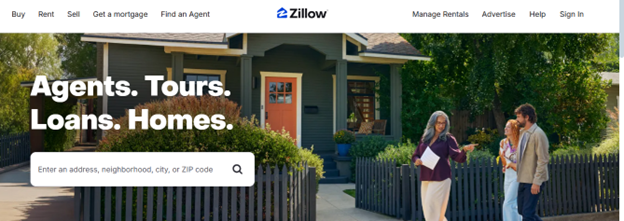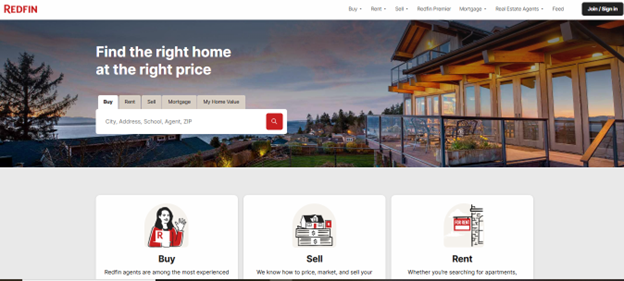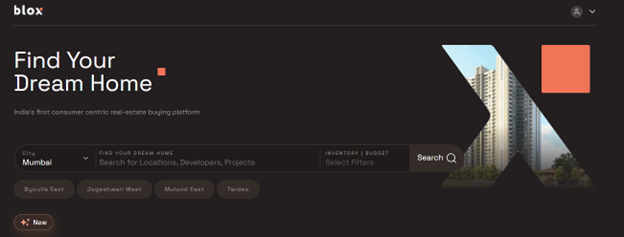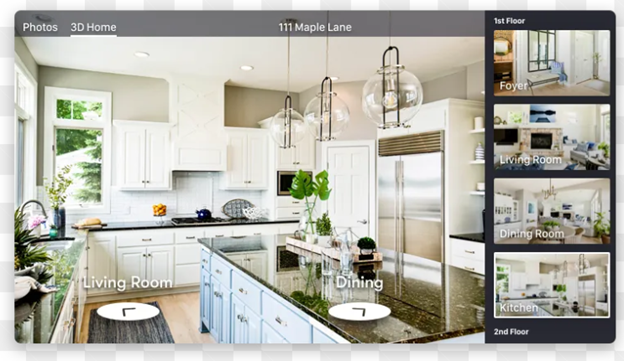The Gamification of Real Estate: Apps, VR, and Interactive Interfaces

Let’s be honest — real estate has long been stuck in a maze of paperwork, jargon, and slow-moving processes that confuse more than they help. Now, thanks to gamified apps and virtual interfaces, exploring real estate can feel more like leveling up in a game than filling out forms at a broker’s office.
You can explore homes in 3D, earn rewards, or even get matched to properties like a quiz. And it’s helping people feel more confident about their choices.
In this piece, we’ll look at how gamification, VR, and smart interfaces are making the process more engaging,
Real Estate Apps That Use Gamification
Here are some apps that use gamification.
Zillow
Image Source: Zillow
Zillow lets users search homes using filters like price, location, and home type. But what stands out is how it adds game-like features. It shows homes that are marked “Hot” based on how many people are viewing them, creating urgency.
You can also create a profile, save favorites, and the app will recommend more listings based on your behavior. The map view acts like a discovery tool — you drag across neighborhoods and explore as if you’re unlocking areas on a game board. It keeps people browsing longer and gives feedback that feels personalized.
Redfin
Image Source: Redfin
Redfin uses interactive tools to guide users through the buying process. When you search for homes, it shows badges like “Price Drop” or “Hot Home,” similar to limited-time offers in games. Its map interface is responsive and color-coded, which helps users spot homes that match their budget quickly.
You can set a goal, like buying in 3 months, and track your activity as you go. There’s also a feature where users get alerts and updates when a saved home changes status, keeping them engaged.
Realtor.com
Image Source: Realtor.com
Realtor.com focuses on real-time property updates, but it adds gamified elements like swipe-based searches and interactive filters. The app shows price drops and time on market, encouraging users to act fast on listings.
It also lets users save searches and get daily alerts, which builds a habit — like checking into a game. One helpful feature is the school and neighborhood rating overlay, which lets users compare homes by area quality without needing to leave the app.
Blox (blox.xyz)
Image Source: Blox
Blox is a group-based property discovery app. It turns the home search into a shared experience — users can invite friends or family to review listings, vote, and comment together. The app includes leaderboards for fun challenges, like finding the best deal under a budget or choosing a home closest to schools or parks. It uses progress bars, checklist-style interfaces, and bright visuals to keep users engaged.
VR and AR in Real Estate
Here’s how VR and AR are being used in real estate right now, and why they’re more than just tech.
Virtual Home Tours Feel Like Real Visits
Instead of flipping through photos, people can now explore homes as if they’re walking through them. VR tours let you look around the rooms, move from space to space, and even turn corners — all from your phone or headset. It feels more like a real showing, which helps people understand the space better before they visit.
“Virtual tours aren’t just visual anymore — clear audio and captions are becoming essential too,” says Ernestas Duzinas, Founder/CEO of GoTranscript Inc. “Adding accurate transcripts or subtitles makes property content more inclusive and accessible, especially for international buyers or those with hearing challenges.”
That’s very useful for buyers who are in a different city or country. They can explore multiple homes in a day without stepping out of their house and understand details easily. And for sellers, this means fewer “just browsing” visits and more serious buyers coming through the door.
Saves Time and Energy for Everyone
Before VR, buyers had to physically visit every home that caught their interest. That meant spending weekends driving around, only to realize many homes didn’t match expectations.
With VR tours, buyers can narrow things down from their couch. They can skip the homes that don’t feel right and only visit the ones that do.
This also helps real estate agents. They don’t need to schedule as many in-person showings, which saves time and allows them to focus on serious leads.
AR Lets You See What Could Be
Amanda Newton, Founder & CEO of Jimmy Cricket, mentions, “Augmented reality is making it easier for people to choose home décor with confidence — especially when it comes to wallpaper and interior design. Instead of imagining how a pattern might look on their wall, they can now preview it instantly through their phone.”
This has been a game-changer for people working on their homes. AR lets them explore styles they’d usually skip, test out bolder prints, or see how something soft and neutral feels in different lighting.
Buyers See Potential, Not Just Reality
One of the most common use cases in AR-driven real estate tools is visualizing interior changes — especially flooring. Whether it’s replacing old carpet with engineered hardwood or testing different finishes in a virtual living room, these gamified tools help buyers picture their future home in a more personal way.
Instead of walking away from a home because of worn-out floors, buyers are starting to see it as a project — one they can shape with confidence.
“Flooring is one of those things people immediately notice, even if they don’t realize it,” says Daniel Tynan, Founder of Pro Hardwood. “When AR lets them test different wood tones or see how light hits a space, it changes the conversation. They stop asking ‘Is this the right house?’ and start asking ‘How would I make it mine?’”
That shift — from passive browsing to active planning — is a big part of why gamification works.
Easily Visualize Outdoor Space
While VR tours and interactive apps focus heavily on interiors, buyers are starting to expect the same clarity for outdoor spaces. Gamified platforms are beginning to include yard dimensions, sun exposure animations, and even landscaping tools that show what the property could look like with added decks, fences — or fewer trees.
This has quietly changed how buyers think. A once-desirable shaded lot might now raise red flags for potential root damage, blocked light, or storm risk. These visual prompts encourage earlier decisions — not just on buying the home, but on preparing the land.
“We often get called after a sale, when a new owner realizes a tree is a liability — leaning, rotted, or too close to the roof,” says Jake Emmanuel, Business Owner & CEO of Trees By Jake. “If real estate apps help people spot those things sooner through smart overlays or AR walkthroughs, it saves everyone time, money, and stress.”
When interactive platforms highlight what’s outside the walls — not just inside — they give buyers a more complete picture of what ownership really looks like.
The Quiet Signals Buyers Are Starting to Notice
Gamified real estate apps are changing what catches a buyer’s eye. Beyond open layouts or sleek kitchens, people now pay more attention to practical features like gated access, reinforced entryways, or smart security. As platforms use overlays, filters, and badges to surface these features, they become part of the conversation earlier — especially in city markets.
“When buyers browse homes through a screen first, they start picking up on things they used to miss — like the type of gate or how secure the entrance looks,” says Beni Avni, Owner of New York Gates. “We’ve had clients mention that seeing a solid gate in a virtual tour gave them peace of mind before they even stepped onto the property.”
As digital tools evolve, they’re not just highlighting curb appeal — they’re helping people spot the signals of a well-protected, well-managed home.
Long-Distance Buyers Can Shop with Confidence
In places like Dubai, London, or New York — where people often invest from overseas — VR is a huge help. International buyers can take a full tour of a home and even ask agents questions over video. They get a much clearer view of what they’re buying, which builds trust and reduces last-minute surprises.
This has also become popular with busy professionals who don’t have time to tour dozens of homes. They can go through a shortlist online and only step in once they’ve narrowed down their choices.
Renovation Ideas Become Easier to Visualize
Many people look at homes not just for what they are, but for what they could become. “The power of AR lies in showing what doesn’t yet exist — but it’s even more effective when grounded in real drafting logic,” notes Brian Curran, Founder of DraftingServices.com. “Tools that integrate actual floor plan data or structural guidelines offer buyers a more realistic vision of what’s possible.”
AR helps with that too. Some tools let users “edit” the home to see what it would look like with different layouts. Want to remove a wall between the kitchen and living room? AR can show you what that would look like.
This helps buyers see the true potential of a property. Instead of walking away from a place that needs work, they start thinking of it as a project they can shape. That mental shift can lead to more offers — especially in markets where inventory is limited.
VR Open Houses and Live Walkthroughs
Some agents now host virtual open houses. These are scheduled events where buyers can log in and explore the home through a VR platform. The agent is usually available in real-time to answer questions, point out details, or even show parts of the neighborhood.
This kind of experience is less stressful for buyers. They don’t have to squeeze into crowded rooms or feel rushed. Instead, they explore at their own pace and reach out when they’re ready.
Listings with VR or AR Get More Attention
Homes that include VR tours or AR features tend to perform better online. They get more views, more clicks, and often stay in buyers’ minds longer. That’s because they offer a better experience — something that feels interactive and personal, rather than flat and generic.
According to Dan Close, Founder and CEO at We Buy Houses in Kentucky, “Virtual walk-throughs let people picture themselves in the space before ever stepping inside. It saves time for both buyers and sellers, and often leads to faster, more confident decisions.”
Zillow, for example, now offers Zillow 3D Home, which lets sellers and agents upload a full virtual tour.
Image Source: Zillow
Buyers using the Zillow app can view the home from all angles and move room to room just by tapping. This gives people a stronger sense of space and layout, helping them decide faster if the home is a good fit.
Gamified Expectations are Promoting Real-World Readiness
As real estate platforms adopt game-like interfaces and immersive tech, they’re also raising expectations for what buyers experience in person. When a user takes a virtual tour or interacts with a progress bar showing “construction at 65%,” they expect the physical site to match that digital promise — organized, safe, and accessible.
“We’ve noticed a shift,” says Indie Basi, Director of Wade Temporary Fencing. “When listings show up in polished apps with digital renderings and VR walkthroughs, buyers arrive expecting professionalism on the ground too. Clear boundaries, safe access, and a well-managed site have become part of the overall experience — not just logistics.”
In that sense, gamification isn’t just changing the interface — it’s reshaping what trust and transparency look like across the entire real estate journey.
Interactive Overlays Are Changing What Buyers Prioritize
Gamification and smart interfaces are also shifting what buyers look for. It’s no longer just about square footage or the number of bedrooms — users now explore homes through overlays that show neighborhood data, school ratings, walkability, and even air quality.
Modern apps are using this data to create interactive maps, color-coded filters, and even “health score” badges for properties. That small layer of interactivity can nudge users toward homes they might not have considered — and give them more confidence in their decisions.
“Air quality is becoming a serious consideration for homeowners — especially in cities,” says Tim Scott, CMO of Wonderfil Air Filters. “When real estate platforms include air data as part of the user experience — even something as simple as a filter or badge — it changes how people search. It adds a layer of trust and shows the platform cares about health, not just aesthetics.”
As interfaces become more dynamic, buyers are starting to value homes not just for how they look in virtual tours — but for how livable they’ll be once the headset comes off.
Benefits of Gamification in Real Estate
Here are the benefits of gamification.
Keeps Buyers Engaged Longer
Real estate platforms are moving beyond static photos and listings. Gamified tools like interactive maps, visual badges, and personalized home-matching scores are helping people stay curious and active on the site. These features turn the home search into something more dynamic — a bit like a game, where each click or filter feels like progress rather than work.
And that’s the point — when the process feels intuitive and rewarding, buyers spend more time browsing. They dig deeper into listings, revisit neighborhoods, and narrow in on what really matters to them. This kind of engagement isn’t just good for platforms; it’s also helping people make better, more confident decisions.
Chris Hall, Owner of North Lake Tahoe Cleaning, explains, “It’s the same idea we see in property care. When the experience feels smooth, and people can interact on their terms, they stay longer — whether that’s in a home, on a rental site, or on an app.”
By giving users tools that respond to their choices, real estate platforms aren’t just selling homes — they’re helping people picture their lives in them. And just like in hospitality or property management, that extra layer of ease makes all the difference.
Showing How a Home Really Works
Gamified tools in real estate are evolving — from maps and price trackers to overlays that visualize how a home works. Some listings now show live data or historical trends around utilities, air quality, or connected device status. This extra layer helps buyers feel more in control — especially when touring remotely.
“The moment an interface shows how a space performs — not just how it looks — engagement goes way up,” says Sebastian Stute, CEO of Smartmakers. “Real estate apps that integrate real-time or historical property data build trust. They’re not just selling a vision — they’re backing it up with numbers.”
This shift from static listings to dynamic, data-backed experiences could be the next frontier of property tech — especially as buyers get more used to smart homes and connected living.
Makes Complex Steps Easier to Follow
Buying or renting property can feel confusing. Gamified tools break the process into smaller, easier steps — like progress bars or checklists that show how far you’ve come. These features guide users through things like pre-approval, scheduling visits, or making offers. It feels more like a path you can follow, not a maze you’re stuck in. This helps reduce stress and gives buyers more confidence to keep going.
Helps Users Make Faster Decisions
When apps show “hot listings,” rewards for fast actions, or limited-time price drops, they encourage users to act sooner. It’s similar to how games use urgency to drive decisions. This kind of feedback helps users avoid overthinking and makes the experience feel more active. For sellers and agents, this can lead to quicker offers and less time sitting on the market.
Modern real estate platforms are taking a page from the e-commerce playbook — offering rewards, badges, and even partner discounts to keep users engaged and drive conversions.
Whether it’s a first-time buyer badge, a “refer a friend” bonus, or a discount on moving services, gamified incentives add emotional momentum to the decision-making process.
And it works. These small nudges make buyers feel like they’re unlocking progress — not just checking boxes.
“Promo codes and time-limited offers work because they reward fast, confident action — which is exactly what real estate platforms need to encourage,” says Sundze Mohammed, Founder & CEO of RTCoupons. “When you connect real estate steps with real-world savings — even small ones — it turns an overwhelming process into something users want to keep coming back to.”
As gamification grows, expect to see more platforms offering embedded perks, loyalty-style tools, or service coupons tied to property milestones — like move-in dates or mortgage pre-approvals.
Builds a More Personalized Experience
As users explore homes, save favorites, or take quizzes, the platform starts to learn what they like. It then recommends homes that match those interests — like how games adjust based on how you play. This makes the whole experience feel more tailored and relevant. Instead of wasting time on random listings, users get a clear set of options that match their budget, style, or goals.
Boosts Learning and Confidence
Gamified platforms often teach users along the way — especially helpful for first-time buyers. Whether it’s a quiz that explains mortgage terms or a simulator that shows how much monthly payments might be, these tools help people learn without feeling overwhelmed.
As Joe Montanti, Founder & CEO of MDRepairs says, “We see it all the time — people forget to back things up because they’re busy, confused, or just assume their device will never fail. That’s why real estate apps with gamified profiles are so smart. Even if your phone dies, your saved homes, progress, and preferences are still there waiting — it makes the process feel lighter, safer, and even fun.”
The more they understand, the more confident they feel. And confident buyers are more likely to take action.
Encourages Repeat Visits and Sharing
Games work because they keep people coming back — and the same goes for real estate apps that use gamification. Features like rewards for daily check-ins, updates on price drops, or progress tracking give users a reason to return often. Some platforms even let users invite friends to vote on listings or join team challenges. This makes the process more social and keeps people engaged even if they’re not ready to buy right away.
Helps Agents and Sellers Stand Out
Nowadays, attention spans are short — and listings that feel clunky or flat often get skipped. That’s why more agents are turning to gamified features like VR tours, interactive maps, and personalized search paths. These tools do more than just look modern — they make the entire experience easier for buyers to engage with.
For sellers, it means listings that stand out quickly and attract the right kind of interest. Buyers can explore a property in-depth without needing to book a showing first, saving time for everyone involved. For agents, it leads to more qualified leads and fewer “just browsing” viewings.
Kim Lee, Realtor of Kim Lee Real Estate, highlights, “When buyers can explore a space on their own terms — virtually walk through it or see how it fits into their daily life — they connect faster. That connection is what turns interest into serious offers.”
Potential Risks and Criticisms
These are some risks of gamification.
It Can Oversimplify Serious Decisions
Gamified tools often make buying or renting feel fun and fast — but real estate decisions come with long-term consequences. A flashy interface, a countdown timer, or a “hot listing” badge can push people to act quickly, even when they’re not ready.
That pressure can cause buyers or renters to overlook real issues — like property maintenance needs, roofing conditions, or long-term upkeep costs. These are details that don’t always show up in a virtual tour but can make or break the experience of living in a home.
Harry Singh, Owner of Keystone Roofing, shares, “People often focus on interiors or flashy features, but what’s above their heads matters just as much. A rushed decision might skip over signs of roof wear or hidden damage — and those surprises can be expensive down the line.”
Gamification has its benefits, especially for discovery and engagement. But it works best when paired with solid advice and a careful review of the property
Gamification Can’t Cover Up Hidden Problems
Interactive real estate platforms make browsing homes feel more dynamic, but they’re also being used to surface hidden issues that buyers may have overlooked in traditional listings. New tools now integrate inspection data, property health scores, and even past repair records. For plumbing — one of the costliest hidden issues — this is a major shift.
Smart overlays, AR tags, or listing badges that highlight plumbing status (or alert potential red flags) help buyers make informed choices — and reduce post-sale regret.
“Some of the most expensive problems in a home are completely invisible during a walkthrough,” says Luis Tabango, Founder & CEO of Leak Experts USA. “If real estate apps start flagging potential plumbing risks — even through something as simple as a checklist or status icon — it empowers buyers and sets better expectations.”
When Gamification Becomes Friction Instead of Flow
As gamification spreads across real estate apps — from progress bars to personality quizzes — there’s a risk of overdoing it. Poorly implemented features can feel forced, distracting, or worse, manipulative. The key is designing game-like systems that feel intuitive, helpful, and aligned with what users are trying to accomplish.
When the interface feels natural, users stay longer, click deeper, and build trust with the platform.
“Gamification works best when it disappears into the experience,” says Eyal Oster, CEO of WEM.io. “The moment it feels like a trick — or slows users down — it breaks the flow. In real estate apps, small interactions like visual progress, smart feedback, or guided navigation can make a complex process feel calm and human.”
In other words, good design makes the game invisible — and the user feel in control.
Creates False Urgency
Many platforms use things like timers, badges, and alerts to push users to act quickly. While this might boost engagement, it can also create stress or push people into rushed decisions.
A house marked “hot” might just have a lot of views — not actual offers. This kind of design can trick users into thinking they’re about to miss out, even if there’s no real reason to hurry.
Can Be Addictive Without Action
Gamified real estate apps are built to keep people engaged. And they work — users can spend hours taking quizzes, bookmarking listings, and exploring virtual homes. But while all that activity feels productive, it often leads nowhere.
It’s like scrolling through social media — entertaining, but not necessarily useful. Many users get stuck in the cycle of browsing without ever taking a real step — like speaking to an agent, checking their budget, or getting pre-approved.
“We see a lot of people who’ve spent months looking at homes online but haven’t done a single check on their financing,” explained Bryan Dornan, Mortgage Lending Expert & Founder at RefiGuide.org. Before the serious search begins, it’s smarter to get clarity on what you can afford. It saves time and narrows your options.”
Without a plan or financial prep, the excitement can turn into stress. People end up with decision fatigue, unsure what they’re looking for or whether they can even move forward. Real progress happens when browsing is paired with action — especially when it comes to big investments like a home.
Tips for Using Gamified Real Estate Tools Wisely
Here are some tips for using gamified real estate tools wisely.
Don’t Trust Every Badge at Face Value
Badges like “Hot Home” or “Price Drop” can grab attention, but they don’t always tell the full story. Just because a listing says “trending” doesn’t mean it’s a great deal — sometimes it’s based on views. And in many cases, those tags are added automatically by the platform, not by an expert who’s actually seen the property.
That’s why check the home’s price history, condition, time on the market, and inspection notes before making any assumptions. Use the badge as a prompt to ask deeper questions — not as the final reason to act.
Raymond Leung, Founder & Financial Strategist at Pivot Advantage, noted, “Labels can create false urgency, especially in big decisions like buying a home or planning finances. It’s always smarter to slow down, check the facts, and make sure the numbers add up.”
A home might look great online, but smart decisions come from real details. When in doubt, dig deeper and ask for clarity.
Don’t Let Gamified Features Rush Your Decision
Countdown timers, flashing badges, and limited-time offers are designed to grab attention — and they work. But when you’re buying a home, these tools can create pressure that leads to rushed decisions. Just because something says “Only 2 Left!” doesn’t mean it’s the right fit for your life or budget.
Home buying should be thoughtful, not impulsive. Pause when things feel too fast. Does the home match your needs? Can you comfortably afford it? Have you seen all the fine print? These are questions worth asking before locking anything in.
Julian Merrick, Founder of SuperTrader, says, “Urgency can cloud judgment — whether you’re trading stocks or buying a house. You make better decisions when you slow down, review the data, and act with a clear mind.”
Keep Your Search Focused
Apps are designed to keep you scrolling. Before you know it, you’ve saved 75 listings — but can’t remember why. That’s when decision fatigue sets in. To avoid this, set clear filters before you start: max budget, number of bedrooms, neighborhood preferences, and must-haves like a home office or outdoor space.
Limit yourself to a small list of saved homes — ideally 5-10 at a time. When you find something interesting, take notes on what stood out and what concerns you have. This keeps your search grounded in what actually works for your life. You can always adjust filters later, but don’t get lost chasing listings you’d never seriously consider.
Use Progress Tools to Stay Organized
Many apps now offer checklist-style tools that guide you through the home buying process — from pre-approval to closing. These visual steps help buyers feel in control and know what’s next. They’re especially useful for first-time buyers who want to stay organized and avoid missing anything important.
Leo Baker, Chief Technology Officer at Vendorland, mentions, “The best tools don’t just show progress, they help people make smarter decisions at each step. When tech is designed thoughtfully, it guides users without rushing them, and that’s when it’s most effective.”
That said, checking off boxes shouldn’t be the end goal. Take time to understand what each stage really means.
Try Interactive Tools — Then Double-Check with Reality
Virtual tours, AR tools, and design simulators can make a home look perfect. But screens don’t show smells, street noise, or how the sunlight really hits the windows. Always follow up virtual tours with real-world checks. Visit the neighborhood at different times of day. Walk through the home and pay attention to details like the condition of floors, plumbing, or windows
According to Mohammed Al-Arnawoot, CEO of DraftAid , “One of the biggest gaps we see in home planning is when buyers rely only on visual mockups without having clear, to-scale documentation. Having accurate 2D drawings based on the real structure helps you avoid layout surprises and makes it easier to plan renovations or furniture fitting later.”
If you’re buying remotely, ask your agent for a detailed video walk-through — including outdoor space, views, and even ambient sound. Use AR to imagine changes like flooring or paint, but confirm with a contractor that those ideas are actually doable within your budget.
Don’t Rely on the App Alone
Gamified real estate tools are great for browsing, comparing, and exploring ideas. But they don’t replace professionals. Agents know the area, understand market trends, and can spot red flags that an app can’t. Home inspectors can explain risks hidden behind walls, and contractors can give real estimates for renovations.
Use the app to narrow your list — then bring in experts to go deeper. Ask your agent about recent comps, how long homes like this have been sitting, and what you might negotiate. Experts turn surface-level browsing into smart decision-making. The app helps you get started — professionals help you close with confidence.
Don’t Decide Too Fast
Instead of liking every nice-looking listing, save only the ones that truly match your top needs. Limit yourself to a shortlist of 5-7 homes, then compare them side by side using features like layout, natural light, outdoor space, and location. Ask yourself: What are the trade-offs? Which homes keep calling you back? If something loses appeal after a few days, take it off the list.
Matt Bick, Director of Alan Bick Engagement Rings, adds, “Just like you wouldn’t rush into picking an engagement ring, the same goes for finding a home. Both are personal choices that should reflect what really matters to you. Take time to compare, reflect, and trust your instincts. This approach helps move from emotional reactions to clearer decisions.”
Watch Out for Emotional Traps
Progress bars, points, badges — they feel good. You feel like you’re moving forward. But gamification is designed to reward behavior, not always results. A badge for “first virtual tour completed” doesn’t mean the home is right.
A filled progress bar doesn’t mean you’re ready to buy. Be mindful of how the app makes you feel. Excitement is fine, but don’t mistake it for confidence.
“Progress tools work best when they guide people, not rush them. In healthcare tech, it’s easy to confuse ticking steps with making informed choices — the same applies here. Every step should add clarity,” said Satyajit Mandal, Head of Global Sales at CLINICEA.
Use logic and lists alongside emotion. Write down your needs and goals and check if the home supports them. If you’re unsure, pause — not because of fear, but because clarity matters more than momentum.
Use Group Features to Get Input
Some apps let you invite family or friends to vote on listings or leave feedback. This is helpful when you trust the people involved and you’re stuck between similar choices.
But too many voices can make things cloudy. One person may love the kitchen, another might hate the flooring, and someone else may just be comparing it to their dream home.
Take notes, but remind yourself: you’re the one living there. Use group tools to get new perspectives, but stay clear on your own priorities. If feedback confuses you more than it helps, take a break from sharing and go with your gut.
Use the App Daily
Gamified apps often give nudges — “Check in today for new listings” or “You’ve unlocked a badge!” That’s fine, but don’t let it eat up your time. Real estate browsing should support your decision.
Set a schedule. Maybe check the app for 20 minutes in the morning and 10 minutes at night. Use alerts and saved filters so the app works for you, not the other way around.
“In both finance and real estate, structure beats emotion,” adds Eduard Tupikov, CMO and Co-Founder of Finelo. “Set limits for how often you engage, or you risk confusing activity with progress. The real wins come from clear goals and steady actions.”
If you catch yourself swiping endlessly, take a step back and revisit your goals. The goal is to make progress.
Conclusion
Gamification is giving real estate a fresh new feel. It’s turning boring steps into smoother, more useful experiences. With things like VR tours, rewards, and helpful apps, people can explore homes in ways that feel simple and even fun.
But while these tools make the process easier, they still need to be used with care. Buying a home is a big step, and it’s important to stay focused on what really matters.
If done right, gamification can help buyers and sellers feel more confident, save time, and make better choices.








